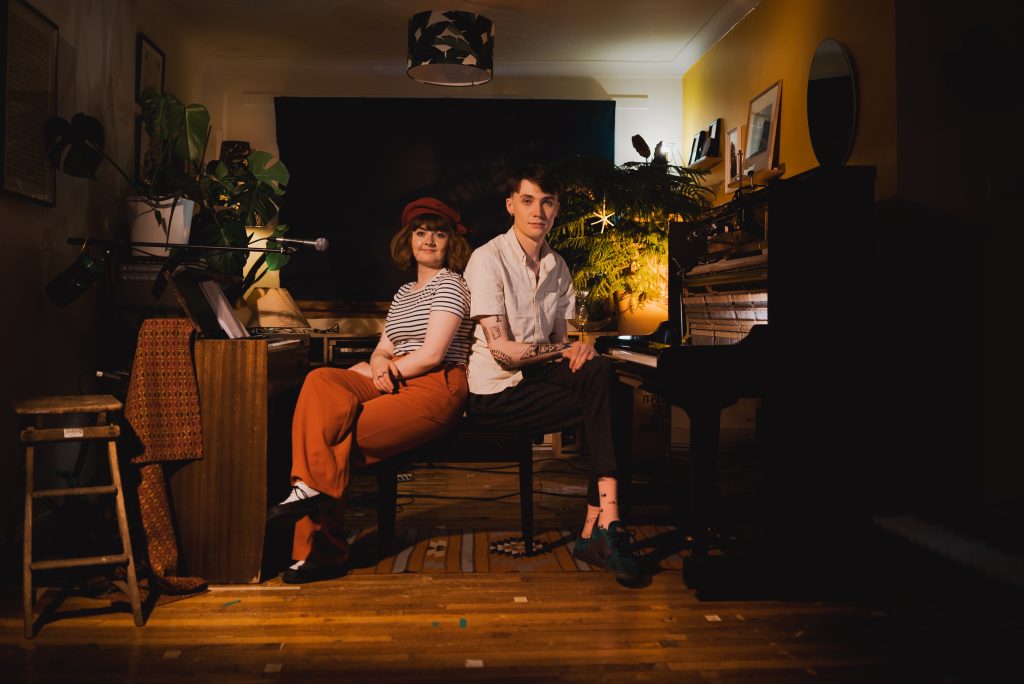📷 by Orla Stevens
Our album ‘Fragments in Time’ has been out for just over a month now, which after three years in the making, is still quite hard to fathom!
We took the very first steps towards the project way back in May 2020. A couple of months into the first of the Covid-19 lockdowns delirium was setting in. We were incredibly lucky to be able to be at home and safe from most of the health risks that existed at that time, but we were truly climbing the walls of that wee Ibrox flat.
The length of that first lockdown was almost exactly the same amount of time as we had lived together – Rhona having moved up from London and taken over a then-vacant room in Joe’s flat. Before that, we hadn’t played music together (or really hung out that much), since we were at music school together – almost ten years previous. Thankfully, settling into locked down life as flatmates, we got on like a house on fire.
Like for all folk who might be self-employed and connected in some way to the world of events, the first few weeks of lockdown were quite insane: Rhona was nearing the end of the final year of her music degree, with an honors project of self-penned indie bops for herself + band still to record, and Joe was gearing up for a year which was set to contain upwards of 80 shows across multiple continents. For us both, there was a period of weeks of re-arranging, re-arranging again and then trying once more, before accepting that life as we knew it was going to be on pause for the foreseeable.
Initially, we coped with that in different ways. Rhona made one thousand paper cranes (yes, it was really one thousand – she counted), and Joe compiled and released the Braw Sailin’ Collection – a compilation of original tunes from members of Tannara, Westward the Light and Charlie Grey and Joseph Peach. With those projects complete, our minds both seemed to turn collectively back to music.
At that time, Joe was a member of a small production studio just a stone’s throw away from the flat. Once we established that it was legal for us to travel from the house to spend time there, we started doing so frequently. Not with any particular ideas in mind, but rather just to re-engage with the act of creating.

One of those early studio days led us to a common ground in the writing of Violet Jacob. She was a Scottish writer, alive between 1863 and 1946, who wrote across mediums and languages. We discovered we had a shared love of her Scots poetry. Her work brims with themes of nature, place, longing, loss, grit, determination and the passing of time – all of which were particularly salient in those early, uncertain pandemic weeks.
Fellow folkies will definitely know a couple of her works previously set to song – The Wild Geese (also known as Norland Wind), and Baltic Street.
Our journey with her work for this album started with what ended up being the 4th track – Lirk O’ the Hill, or to give it its full and proper title – The Field By the Lirk o’ The Hill. Rhona had set this poem to music a number of years previously, and taking her original melody, we piled a whole bunch of ideas in. Working mainly in Ableton, that early draft was a washy, electronics and sample-based soundscape. To us, it worked. Working quite quickly we found a number of Jacob’s other poems that suited being re-made as songs.
The music we made in those initial steps in the project was very tactile and exploratory. It was quite new to us both and really exciting to be building soundscapes around songs – using found-sounds and making new sample instruments to draw out themes and ideas present in Jacob’s lyrics.
That process quickly grew further arms and legs again. We happened upon a number of ideas and sounds that while really exciting on their own, were not working in the context of the songs. These turned into instrumental numbers, which we were thinking of almost straight away as interludes. Sculpting those bridging tracks brought us to the realisation that we could aim to make this body of music (we still weren’t thinking about it as an album at that point) a straight-through listen.
The end of 2020 brought with it a first draft of the Fragments in Time album. Left-field and experimental, it would never have stood up as an album release, but it was certainly unlike anything either of us had made before.

At the turn of the year, moving flat, starting new “we can’t be musicians so what else can we do for the moment” jobs, and a couple of other changes meant the project was shelved for almost 12 months.
Returning to it, the delirious time in which the music was made shone right through. We were amazed, and slightly horrified at some of the creative decisions we’d taken – there were a lot of weird synth sounds!
But there was something about it that merited more attention. Over a few months of listening to the demos, and a huge rake of other stuff, and chatting influences and ideas, we settled on an approach that kept some of the original idea, but that also contained a path to making something “finished”.
The bones of the album are as they were in late 2020 – underpinned by hardware synths, sampled instruments and natural world samples. Given Rhona’s background in Indie stuff, and having listened to a lot of 60s-70s big band, soul and jazz stuff, we were really keen to see if we could get more of a core “band” sound coming through, with some of those bigger sweeping string textures you’d hear on an Etta James record.
So with that, we set out to re-make the album, with a band and instrument list comprising: vocals, piano, harmonium, rhodes, various synths (those are the bits we played); and string quartet, saxophone, kit, bass and backing vocals.

One of the first steps in the project’s transition from left-field experiment to the album was in developing our use of natural world samples. Our first draft drew heavily from the BBC’s sound effects library, an amazing bank of samples gathered by the BBC over a period of decades. These were only placeholders though. Aside from licensing challenges to use those sounds commercially, for the real thing, we felt it was essential for us to be more connected to the sonic world we were creating.
Happily, soon after reaching this decision, we set off to walk the Camino Frances. A 700km hike from Saint-Jean-Pied-de-Port, through the Pyrenees and then heading West, crossing Spain to reach Santiago de Compostela. Along our way we captured a huge range of sounds, which went on to form the bulk of the samples used on the record. Aside from being a big ol’ trachle, the walk was quite a transformative experience for us both, so it’s been wonderful to be able to bring that into this album in a really tangible way.
As an aside, the sample which perhaps features most prominently on the record is of Joe’s great granny Kate Shaw. In the 1960s, Dr John MacInnes spent time in Joe’s native Achiltibuie, recording the local stories, music and language for the School of Scottish Studies. Dr MacInnes made almost 30 recordings of Kate, discussing everything from place names, her day to day life, legends, and the supernatural. All in her native, very distinctive Gaelic. We thought long and hard about including spoken Gaelic on an ostensibly Scots language album, and settled on the conclusion that while separated by language, the themes and heart of both VJ’s lyrics and KS’s chat are deeply shared.
Returning from the Camino, our minds turned to writing string parts and recording our instrumental parts. At its heart, this is a very home or close-to-home made album, almost all of that took place in the home-studio corner of our living room – this is also where all of the music videos were shot.
Largely, we didn’t have to travel far either to record the other musicians who so beautifully lent their talents to this record. It was a mere hop and a skip down the road to the Sherbrooke Mosspark parish church for strings recording. Our quartet: Laura Wilkie, Chloë Bryce, Eilidh Randall and Alice Allen made an incredible job of bringing the parts to life.
Percussion and bass gurus Mattie Foulds and Charlotte Printer beamed themselves in from their home studios, coming up with the goods with total ease. And our apologies to Matt Carmichael for coming round to the flat for what we wouldn’t be surprised to hear would be the least professional recording session of his career. He spent the day sandwiched into our homemade “sound booth”, consisting of a pile of duvets piled up on Rhona’s bed in front of an open wardrobe. We also owe him our sincere thanks for absolutely knocking it out of the park, despite the circumstances!

A notable exception to the close-to-home theme was in making the cannonball run up to Ardnamurchan for the day to record Annie Grace’s backing vocal for Baltic Street – the final song on the album. Making this trip was the realisation of a long-held ambition of Joe’s, who since re-making the melody for the song, had been sure that Annie and Rhona’s voices together would be the finishing touch that would bring the song together.
We were delighted to discover that this was exactly the case. After much back and forth on diaries, we managed to find a time to grab Annie’s vocal three days before the album was due to go to mix. She very graciously made time for us on her lunch break, and we tracked the very last piece of the album in her living room. It works wonderfully, and if we could change one thing about the album it would be to have Annie on there throughout.
In post-production, we were lucky to have the ears of Mattie Foulds on mix. We both love working with him – he’s done a couple of Rhona’s recent singles, and this album represents the 14th release he’s worked on with Joe. He really made the sound of this music the best it could be. Katie Tavini added the cherry on top with a sensitive yet punchy master.
The visuals for the album: cover, photography and videos, and animation were made by Scottish (but Berlin-based) artist Orla Stevens. Her approach and artistic vision aligned really well with the feeling and themes of our project. Orla is also Rhona’s older sister, so it was a great excuse to get to spend some time together and collaborate!
And after all that, Fragments in Time launched on 29 September, the day after Rhona (and Joe’s mum’s!) birthday! We’re incredibly proud of it, and it’s wonderful (if slightly surreal) to finally have it out in the world.
In making all of that happen, we owe an enormous debt of gratitude to the funders who supported the project. Creative Scotland, the Marchus Trust, Fenton Arts Trust and Hope Scott Trust’s investment in this album allowed us to take it from something which existed as 0s and 1s to something tangible.
Making this album has been a huge constant in three incredibly turbulent years. Working on it kept us (somewhat) sane, creative and inspired. Crafting this music was an escape from the upheaval and uncertainty facing the rest of our professional and creative lives, and to boot we’ve ended up with some lovely music!
********************

Fragments in Time is available here
Rhona & Joe’s socials:
Instagram – Rhona | Instagram – Joseph | FB Page – Rhona | FB Page – Joe





